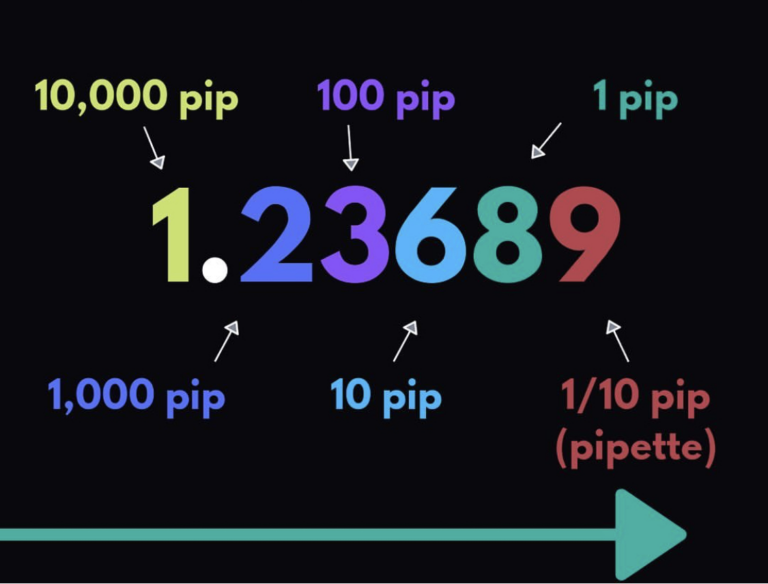
Even seasoned traders often find themselves scratching their heads when it comes to accurately calculating pips in Forex trading. Today, we’re going to dive deep into the history of this concept, ensuring that you’ll never again be confused about what precisely constitutes a pip in currency quotes. Additionally, I’ll share a handy life hack for calculating pip values without relying on a calculator.
What is a Pip?
In the realm of economics, a pip represents the smallest indivisible value of a calculated indicator. In many cases, it’s the last digit in its measurement or the minimum possible fluctuation, applicable to indices, currency pairs, stocks, securities, derivatives, and other financial instruments. The term “pip” originates from the Latin word “punctum,” meaning “point.” Traders use the slang term “pip,” derived from the English “percentage in point,” which denotes “the corresponding percentage share.”
A pip signifies the smallest normal increment in currency prices and is equivalent to 1/100 of 1% of the smallest unit of a currency (such as a cent, penny, or kopeck). For the majority of currency pairs, 1 pip is equal to $0.0001, that is, the fourth digit after the decimal point. Traders need not be perplexed by the difference between “pip” and “point” as, within the context of finance, they mean the same thing.
However, confusion often arises regarding the number of digits after the decimal point in currency pair quotes. Why is it the fourth digit and not the fifth? Since a pip is 1/100 of 1% of the smallest currency unit, usually a cent, and cents are represented by the first two digits after the decimal point (e.g., 1.32), 1/100 of a cent would be represented by the fourth digit after the decimal point (e.g., 1.3201). So, where did the fifth digit come from?
Pips and Pipettes, Old and New Pips
In the Forex market, terms like “pips,” “pipettes,” “old pips,” and “new pips” frequently cause confusion. Let’s take a closer look at these concepts.
Pips and Pipettes
One source of confusion lies in the term “pip” and its fractional version, the “pipette.” The fundamental idea is that a pip is the smallest change in currency price, representing 1/100 of a percent of the smallest currency unit. In most cases, 1 pip amounts to \(0.0001. Just a few decades ago, the fifth digit after the decimal point in Forex quotes didn’t exist, so there was no room for confusion. To offer narrower spreads, the American broker Oanda introduced the fifth digit after the decimal point, giving rise to the concept of “pipette,” which is equal to 1/10 of a pip. Thus, 1 pipette is \)0.00001.
Old and New Pips
The primary cause of confusion stems from the fact that, in the Russian – speaking segment, beginners often mistake “pips” for the change in the fifth digit after the decimal point, rather than 1/100 of a percent. Old pips refer to the minimum price change in quotes with four decimal places, while new pips refer to the minimum price change in five – decimal – place quotes. The first Forex brokers only dealt with four – digit currency quotes, hence the name “old pips.” The emergence of accounts with narrow spreads, less than a pip, prompted brokers to introduce five – digit quotes. Novice clients mistakenly called the change in the fifth digit a pip, when in fact, the fifth digit is a pipette, one – tenth of a pip.
For example, for a 4 – digit broker, the EURUSD quote might be 1.3367, whereas for a 5 – digit broker, it would appear as 1.33670. When discussing trades and reports on forums, in books, and articles, both Russian and foreign, it’s customary to use “old pips” (4 digits) to avoid misunderstandings. For instance, if a strategy review recommends a stop – loss of 45 pips, it implies 4 digits after the decimal point – 0.0045. Therefore, “old pips” correspond to 4 digits after the decimal point, and “new pips” correspond to 5 digits after the decimal point.
How to Calculate Pips in the Forex Market?
When determining how many pips the price has moved, the simplest approach is to ignore the fifth digit after the decimal point. It’s similar to how you might disregard the cents when buying a loaf of bread that costs 50 rubles and 30 kopecks, considering it to cost 50 rubles. The same principle applies to pips – just ignore the fifth digit. You may also come across the term “figure,” which indicates a price movement of 100 pips, and here, we’re referring to “old pips.”
How to Calculate the Value of a Pip?
Now, let’s explore how to calculate the value of a pip. The formula is straightforward: the value of a pip in the quoted currency is equal to the position size multiplied by the tick size. Usually, the tick size is 0.0001, but for certain currencies, like those in pairs involving the Japanese yen, the tick size is 0.01.
Let’s illustrate with some examples:
- Direct Quote USD/JPY: Tick size: 0.01, Position size: 1 standard lot (100,000 units of the base currency), Current USD/JPY rate: 78.20. Value of a pip = 100,000 * 0.01 / 78.2 = 12.8 USD.
- Indirect Quote EUR/USD: Tick size: 0.0001, Position size: 0.01 lot. Value of a pip = 100,000 * 0.01 * 0.0001 = 0.1 USD.
- Cross – Rate AUD/CHF: Tick size: 0.0001, Position size: 1 lot, Current AUD/CHF rate: 1.02, Current base currency pair AUD/USD rate: 1.05. Value of a pip = position size * tick size * base currency pair quote / current pair quote. Value of a pip = 100,000 * 0.0001 * 1.05 / 1.02 = 10.3 USD. These examples should help you understand how pips are calculated and how to determine their value for different currency pairs. An easier and quicker way to calculate pips is to use the calculator on the website. By selecting the appropriate program from the drop – down menu in the “Tools” -> “Calculators” section, users can obtain the value of one or any selected number of pips by entering the lot size and choosing the name of the currency pair.
How to Calculate Pips Mentally?
Calculating pips mentally is easy once you know a simple constant. For currency pairs like EURUSD, GBPUSD, NZDUSD, and AUDUSD, when the lot size is 0.1, a 1 – pip price movement costs \(1. Correspondingly, when buying a full lot of 1.0, the minimum exchange rate change will cost the trader \)10. When the lot size is 0.01, it costs \(0.1, and so on. If the stop – loss is set at one figure, or 100 pips, then when the trade protection is triggered with a 0.1 – lot position, the trader stands to lose \)100, and with a 1 – lot position, \(1000. For a 0.05 – lot position with a 10 – pip movement, the cost is 0.1 x 5 x 10 = \)5. Incidentally, the leverage size chosen by the trader has no impact on these loss amounts; it only affects the deposit margin required to open the position. Therefore, the mental calculation method described is universal.
Practical Tips and Nuances
Pips in MT4 – New Pips
Nowadays, most brokers use five – digit quotes even in the MT4 terminals. Previously, five digits were only available in MT5 programs. You can set the profit display in pips in MT4. Click on the right – most column “Profit” of your trading terminal, select the option “Profit” from the drop – down menu, and then choose the line “Pips” from the side list that appears.
Old Pips in Articles and Forums
Note that, in most cases, especially on foreign forums, everything is denoted in “old pips.” Rarely does anyone refer to the fifth digit after the decimal point, except perhaps beginners.
Working with Advisors and Indicators
When using advisors in the Forex market, pay close attention to how pip – related parameters are set. These automated trading tools often contain numerical values for stop – loss, take – profit, grid step, etc., all measured in two – or three – digit “old pips.” In new advisors, usually, no manual adjustment is needed to work with 5 – digit dealing centers. You enter the values in old pips, and the advisor automatically adapts to the quotation system of your DC. In old advisors designed for 4 – digit DCs, it may be necessary to add zeros to the parameters for proper operation in 5 – digit DCs. However, in modern advisors, this process is automated, eliminating the need for additional settings.
Yen – related Pairs and Old Pips
When dealing with currency pairs that include the Japanese yen, pips are calculated by considering two digits after the decimal point, not three. This is crucial for accurately understanding price changes in such quotes. For example, if the USDJPY quote is 146.438, when calculating pips, we ignore the third digit after the decimal point and focus on 146.43.
Using Myfxbook for Unusual Instruments
If you’re unsure how to calculate pips for less – common instruments like Bitcoin, you can utilize the Myfxbook service.
Conclusion
In the Forex market, understanding and correctly calculating pips is a fundamental aspect of successful trading. Even experienced traders can sometimes be confounded by the definition of pips and their values. This article has provided clear explanations of the key points and concepts related to pips. Now, you know the differences between pips and pipettes, old and new pips, and also how to use calculators to determine profit or stop – loss in dollars for a selected trading lot size. Armed with this knowledge, traders can navigate the “mathematics” of the Forex market with greater confidence and understand the intricacies of setting up advisors.
